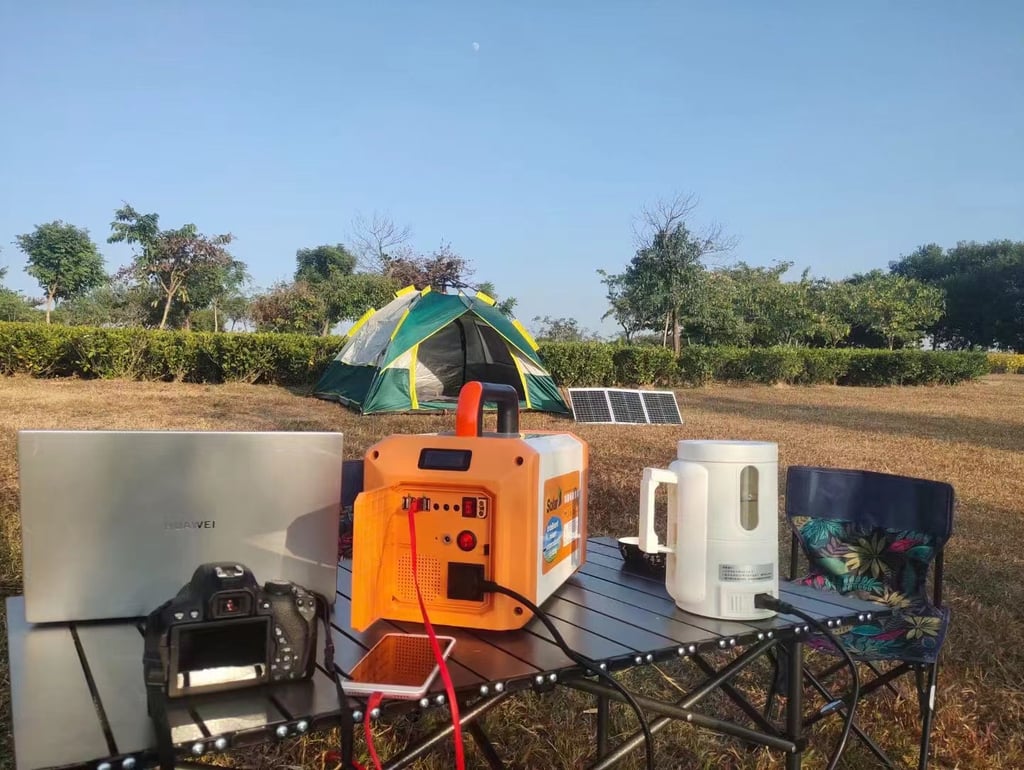Selecting the Right Charger for Your Portable Power Station
5/16/20254 min read


Understanding Voltage Requirements
When selecting a charger for your portable power station, understanding voltage requirements is crucial to ensure optimal performance and safety. Each portable power station is designed to operate with a specific charging voltage, typically indicated in the user manual. Matching the output voltage of the charger to this rated voltage is essential for efficient energy transfer and maintaining the integrity of the device.
If a charger with a higher voltage is used, there is a significant risk of damaging the portable power station. Exceeding the recommended voltage can lead to overheating, resulting in potential equipment failure or even fire hazards. The internal components of the power station, such as the batteries, could overheat and fail, leading to irreversible damage. Therefore, it is imperative that users adhere strictly to the specified voltage requirements—roaming beyond these limits can result in catastrophic failures.
Conversely, using a charger with inadequate voltage can also pose its own set of problems. An underpowered charger may not provide sufficient energy to charge the portable power station effectively. This can lead to prolonged charging times and may ultimately prevent the device from reaching full capacity. Users might find that their power station does not perform optimally, leading to frustration and disappointment during its intended use.
To prevent these issues, always consult the specifications of your portable power station and the accompanying charger. It is advisable to use chargers that are designed specifically for your power station model or are certified by the manufacturer. Precision in matching voltage requirements will enhance the longevity and reliability of your portable power solution, ensuring that it performs as expected when you need it most.
Current Output Considerations
When selecting a charger for your portable power station, understanding the significance of the charger’s output current is pivotal for optimal performance. The output current, measured in amperes (A), directly impacts how efficiently and quickly the battery of the portable power station will charge. It is paramount that the output current of the charger aligns with the power station’s charging current specifications to ensure safe and effective operation.
If the charger’s output current is too low, the charging process becomes inefficient. This can result in extended charging times and may lead to the station not being fully charged, which can compromise the functionality of your devices when you need to use the portable power station. A charger that cannot meet the recommended current requirements may cause inconvenience, especially in situations where time-sensitive charging is necessary, such as during outdoor activities or emergency situations.
Conversely, while it might seem advantageous to opt for a charger with a higher output current, caution should be exercised. Chargers delivering a higher current than specified may indeed charge the station faster, but they can also pose risks. Overcharging or overheating can occur, leading to potential damage to the battery and a decrease in its lifespan. Furthermore, some portable power stations are equipped with safety mechanisms designed to withstand minor fluctuations in current. However, consistently exceeding the recommended output can overwhelm these protective features.
In conclusion, understanding the nuances of current output is essential when selecting the appropriate charger for your portable power station. Ensuring the charger’s output aligns with the station’s charging requirements will facilitate efficient charging and help maintain the integrity and longevity of both the charger and the battery. Making informed decisions in this regard will optimize the performance of your power station while minimizing associated risks.
Connector Compatibility
When considering a charger for your portable power station, understanding connector compatibility is paramount. Various portable power stations utilize different types of connectors, and each has its own specifications and characteristics. This section delves into the importance of ensuring physical compatibility between the charger and the power station, enabling effective charging and, ultimately, the optimal performance of your device.
Common connector types include barrel connectors, XT60 connectors, Anderson Powerpole connectors, and USB-C connectors. Barrel connectors are often found in standard chargers and come in various sizes, typically identified by their inner and outer diameters. It is essential to choose a charger with a barrel connector that matches these measurements precisely; otherwise, the connection may become loose or not function at all, leading to inadequate power transfer.
Additionally, XT60 and Anderson Powerpole connectors are popular in the realm of higher-capacity portable power solutions. These connectors are designed to handle higher currents, making them suitable for devices that require significant power. Users should ensure that the charger's connectors are rated for equal or greater voltage and amperage to avoid overheating or damaging the power station during use.
USB-C connectors are increasingly prevalent, particularly in newer models of portable power stations. Their reversible design adds convenience, but compatibility with a charger should be verified, including necessary power delivery specifications. As you explore different charger options, be diligent in confirming that the physical design of the connector aligns with the charging port of your portable power station. A secure and proper fit is crucial, as this not only enables efficient charging but also safeguards the integrity of both the charger and the portable power station.
Safety Features and Certifications
When selecting a charger for your portable power station, prioritizing safety features and certifications is essential for ensuring reliability and protection during usage. Various safety standards help consumers identify chargers that have undergone rigorous testing and meet essential safety guidelines. For instance, certifications such as UL (Underwriters Laboratories) and CE (Conformité Européenne) signify that the product adheres to specific safety requirements, significantly reducing risks associated with electrical devices.
One crucial aspect of a safe charger is its built-in protections. Look for chargers that include features such as overcharging protection, short-circuit protection, and temperature control. These safety measures are intended to prevent potential hazards, such as overheating, which can result in damage to the charger and the portable power station itself. Overcharging protection is particularly paramount, as it ensures that the power station does not receive too much voltage, which can negatively impact its battery life and overall performance.
Additionally, chargers equipped with thermal management systems help dissipate heat effectively during operation. This feature is vital, as unmanaged heat can trigger a chain reaction leading to malfunctions or even fires. The integration of fuses and circuit breakers in chargers can further enhance safety by providing an immediate response to electrical faults.
It’s crucial to conduct thorough research on the manufacturers and their compliance with relevant safety standards. A reputable manufacturer will typically provide documentation that validates their product's certification. By prioritizing safety features and certifications in your choice of charger, you can ensure a harmonious relationship between your portable power station and its power source, thereby maximizing the longevity and effectiveness of both devices.
